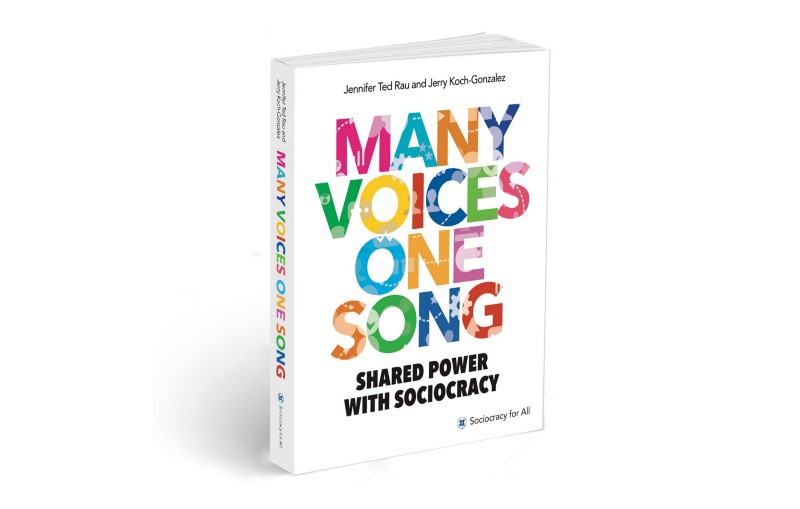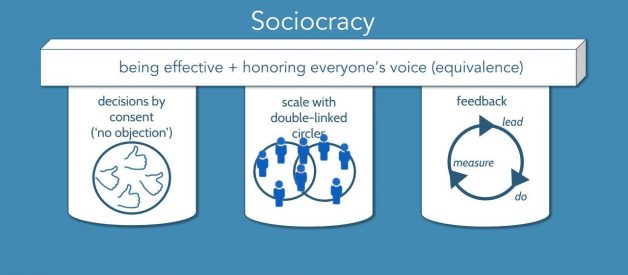This presentation was put together by Jennifer Ted Rau of Sociocracy for All (SoFA) for an on-line introductory course to facilitating sociocratic metings. The text is by Jennifer Ted Rau and Harris Kaloudis and is reproduced here with the permission of Jennifer Ted Rau. Alls visuals by SoFA in this text are licensed under a Creative Commons Attribution-NonCommercial-ShareAlike 2.0 Generic License.
What makes sociocracy distinctive?
 Slide 1 [Creative Commons Attribution-NonCommercial-ShareAlike 2.0 Generic License]
Slide 1 [Creative Commons Attribution-NonCommercial-ShareAlike 2.0 Generic License]
Sociocracy upholds two fundamental principles:
organisational effectiveness, i.e. realising the organisation?s aim and purpose effectively and efficiently; and,
the equivalence/equality between organisational members, honouring everyone?s voice. No-one is silenced, no-one is ignored, no-one is oppressed, no-one holds power over another. In sociocracy there is safe, protected time for everyone to speak and to have their voice respected and their views considered.
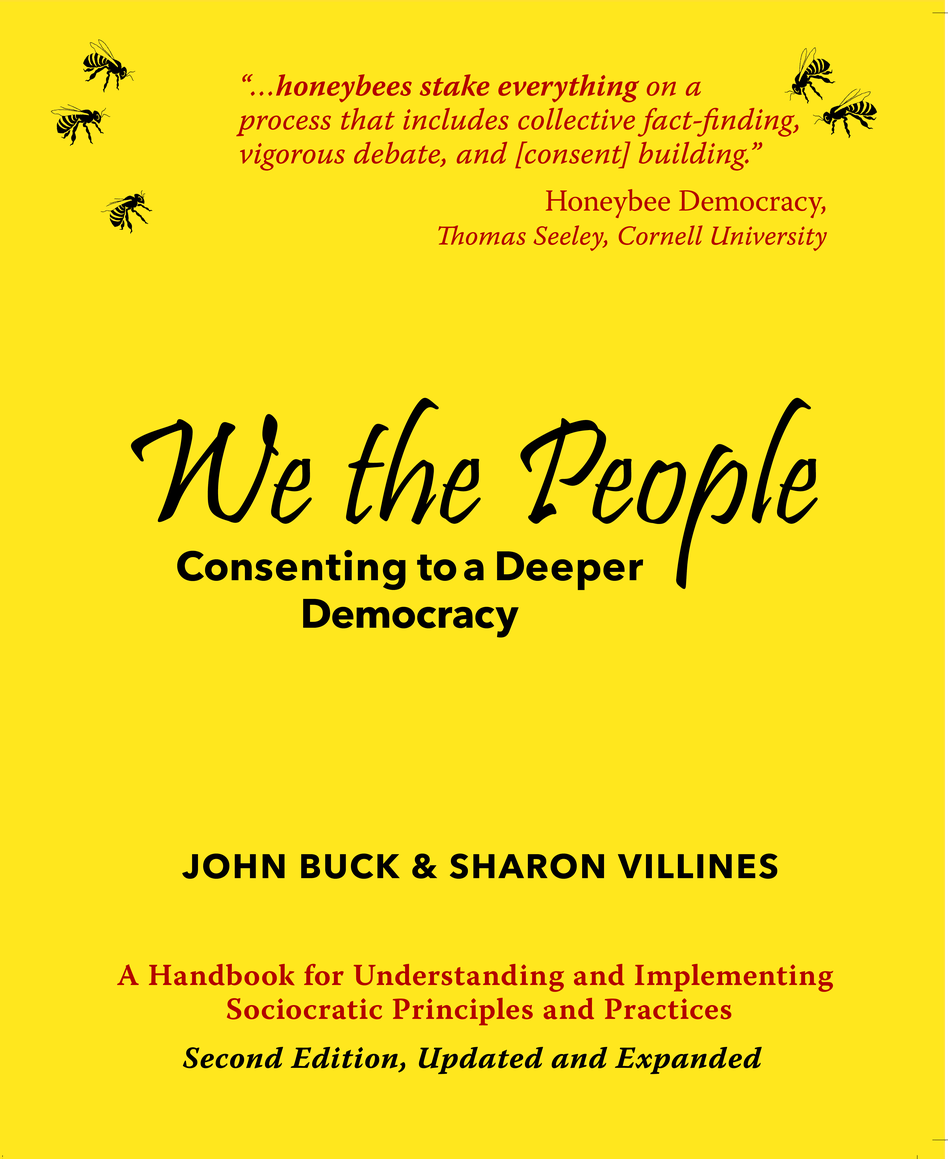 Book Cover of 2nd Edition, 2017
Book Cover of 2nd Edition, 2017
John Buck and Sharon Villines write in their book: ?We the People, Consenting to a Deeper Democracy: a guide to sociocratic principles and methods? (p. 125, 1st edition, 2007):
?? the sociocratic method is a ?tool? and not a philosophy. Its only agenda, political theory or moral stance is to establish and protect the equivalence of each person and enhance their ability to pursue happiness and prosperity.?
(Please note that this view is not universally shared among sociocracy enthusiasts or practitioners.)
Sociocracy serves and realises these principles through three key features (the ?pillars? in slide 1):
- decision-making by consent, as opposed to autocracy, hierarchical authority, majority voting and consensus;
- working groups / organisational units / departments are organised in circles. Separate circles are organised in a fractal-like, nested hierarchy. This is a hierarchy of domains of authority and not of power, control or coercion. Each circle is linked to the circles next to it [i.e. to its super-circle (or parent circle) and to its sub-circle(s) through a double link]. Image 1 below schematically illustrates a sociocratic organisational structure;
- feedback is an integral principle of all organisational activities and roles at all levels.
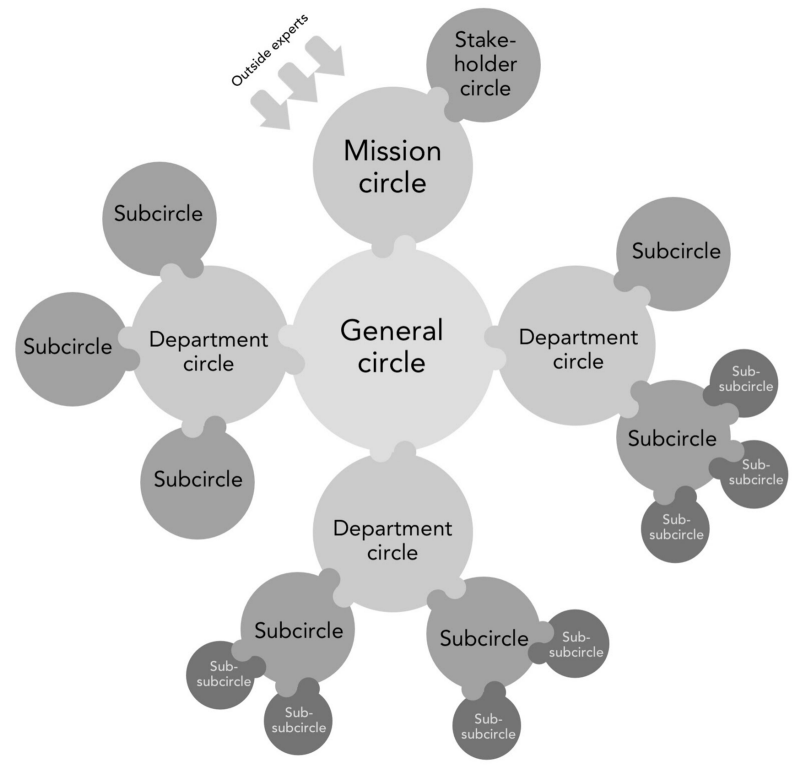 Image 1: Circular organisation. Taken from the book: ?Many Voices, One Song: Shared Power with Sociocracy? by Jennifer Ted Rau and Jerry Koch-Gonzalez [Creative Commons Attribution-NonCommercial-ShareAlike 2.0 Generic License]
Image 1: Circular organisation. Taken from the book: ?Many Voices, One Song: Shared Power with Sociocracy? by Jennifer Ted Rau and Jerry Koch-Gonzalez [Creative Commons Attribution-NonCommercial-ShareAlike 2.0 Generic License]
In the rest of the presentation, we?re going to look at each of the three ?pillars? of sociocracy successively.
Pillar 1: Making decisions by consent
 Slide 2 [Creative Commons Attribution-NonCommercial-ShareAlike 2.0 Generic License]
Slide 2 [Creative Commons Attribution-NonCommercial-ShareAlike 2.0 Generic License]
Every circle has an aim, a description of what they do, e.g. in the Blue Scorcher Bakery in Oregon, USA, there is a circle responsible for pastry, another one for chocolate products and another for bread products. You can see their structure in Image 2 below.
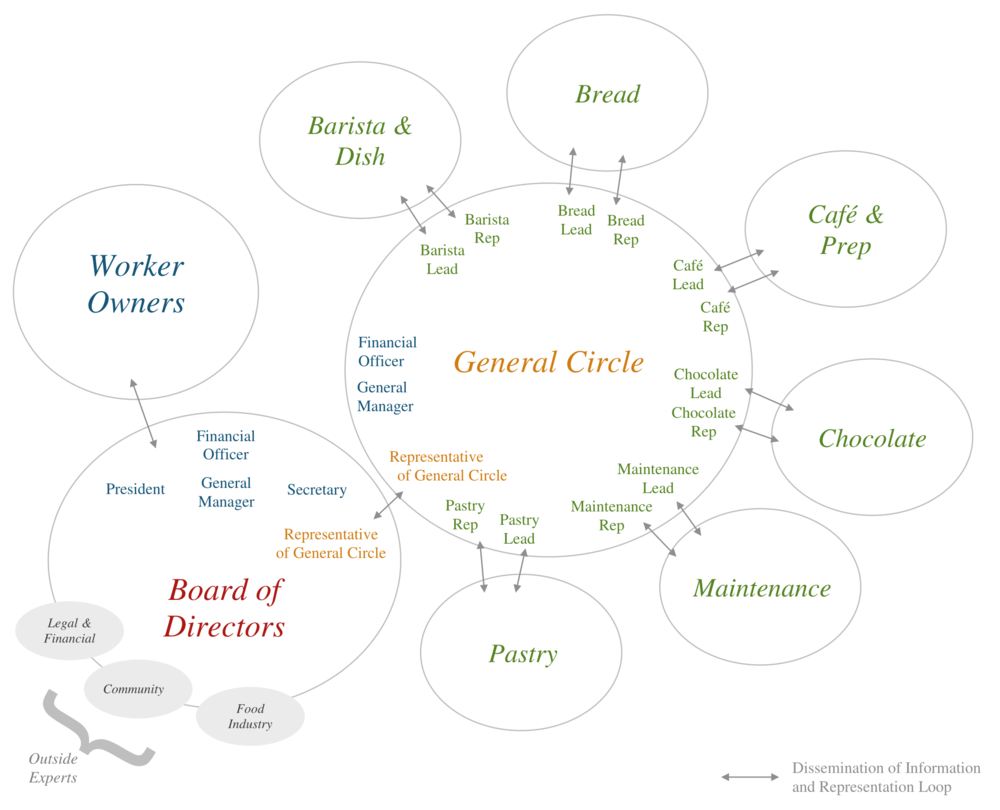 Image 2; Reproduced from: http://www.bluescorcher.coop/governance/
Image 2; Reproduced from: http://www.bluescorcher.coop/governance/
In a co-housing community, a circle may be responsible for ensuring that the roads in the community are kept in good condition and unobstructed by snow, fallen tree branches, debris etc. In a non-for-profit organisation, a circle may be responsible for creating and maintaining the organisation?s website.
The aim of a circle needs to be very specific because, in sociocratic circle meetings, proposals, decisions, arguments, discussions are all related back to the aim of the circle and the way they support and promote this aim or undermine and obstruct it.
Referring again to John Buck and Sharon Villines?s book (2007; p.124):
?Sociocratic debate focuses on the argument, not the majority opinion. In sociocratic organizations, the argument is stated in the context of the aim. What is our aim? How can we best achieve it? Can everyone work toward the aim if we accept this proposal? To ensure that all members of the organization understand the aim of the organization, the aim of their department, and the aim of their own role in that organization, all functions and tasks are defined in terms of the aim. This focus is what makes sociocratic organizations more satisfying for their members and more powerful in doing their work.?
Policy decisions in a sociocratic circle are made by consent. Consenting to a proposal means: ?I have no objection to this proposal and I am willing to collaborate with the other circle members to put this policy in place.? Having ?no objection? does not mean that you think that this is the best solution possible or imaginable or that it ticks all the boxes that are important to you. It means that this proposal is ?good enough? to be put in place for now until it is reviewed, revised and changed. Generally, we aim to ?tweak? how thing work, then monitor how things are turning out and then to ?fine-tune? and ?fine-tune? again on the basis of our experiences, measurement or feedback.
To consent to a proposal, it does not need to be your first preference. It just needs to be within your ?range of tolerance? as illustrated in slide 2 above. A way to illustrate this might be this: if somebody offers me ice-cream, I may wish that it were strawberry (first preference). But if they only had lemon, I would still eat it (lemon is within my range of tolerance). If they offered me liquorice, I would have to refuse it because I am allergic to liquorice (it would be outside my range of tolerance).
In sociocracy, to object to a proposal means: ?if this proposal goes through my work towards the realisation of the circle?s aim and purpose is compromised or impeded?. Objections in sociocracy must be ?paramount? and ?reasoned?. ?Paramount? means that they must be related to the circle?s work and purpose. ?Reasoned? means that they need to be in the form of a rational, sensible, intelligible argument understood by others.
Objections are not seen as roadblocks and obstacles. Objecting essentially means: ?I want to work effectively and this proposal will negatively affect my work so we need to figure out how to make this proposal better?. Objections are not negative. They are seen as positive and constructive; they say ?yes to working?. Our aim as a group is that a proposal is good enough so that everyone can work.
Objections are encouraged in sociocracy. Facilitators are encouraged to be alert to the reservations, hesitations, doubts, niggles, uncertainties, discomfort expressed by circle members in verbal and non-verbal ways. Facilitators are encouraged to ?harvest? objections actively and not to disregard any signs that people may harbour silent reservations.
Pillar 2: Circles and Double-linking
Nested Circles: Sub-circles and Super-circles
 Slide 3 [Creative Commons Attribution-NonCommercial-ShareAlike 2.0 Generic License]
Slide 3 [Creative Commons Attribution-NonCommercial-ShareAlike 2.0 Generic License]
People that work together form a circle. Every circle has a domain, its area of authority. Circles make decisions about everything within their domain and other circles cannot interfere unless their own work is somehow affected by the activities of the other circles. Example: Circle 1(the top left circle in Slide 3) may be the Grade 1 Teachers in a sociocratic school; circle 2 (the bottom left circle in Slide 3) may be the Grade 2 Teachers. Circle 1 has exclusive authority over teaching Grade 1 pupils (e.g. over the curriculum) while Circle 2 has exclusive authority over teaching Grade 2 pupils. Circle 1 and Circle 2 are not linked with each other but they coordinate between them and they deal with things that they need to manage together, e.g. a shared library or a gym, through Circle 3 to the right (a super-circle with Circle 1 and Circle 2 as it sub-circles).
Double-linking between sub-circles and super-circles
 Slide 4 [Creative Commons Attribution-NonCommercial-ShareAlike 2.0 Generic License]
Slide 4 [Creative Commons Attribution-NonCommercial-ShareAlike 2.0 Generic License]
Double-linking is a feature unique to sociocracy. Sub-circles link to super-circles via a double link. The sub-circle on the left in Slide 4 has a ?leader? (who may be appointed by the super-circle or may be elected by the sub-circle). The actual content of the role of the ?operational leader? is determined by the circle through consent. In terms of linking the circles, the role of the ?leader? is to communicate the needs of the super-circle to the sub-circle and to carry information from the super-circle to the sub-circle (reporting down). In Slide 4, the ?leader? is represented by the bottom red person with the arrow pointing left.
The sub-circle also has a ?delegate? elected by the members of the sub-circle. (There are other roles in a sociocratic circle e.g. facilitator and secretary, but we will not cover them here.) The ?delegate? in Slide 4 is represented by the top red person with the arrow pointing right. The ?delegate??s role is to communicate the needs of the sub-circle to the super-circle and to carry information from the sub-circle to the super-circle (reporting up).
Both the leader and the delegate are full members of both the sub-circle and the super-circle. Both have objection rights in both circles so that no circle is lording it over another circle. The right-hand super-circle cannot decide anything without the consent of the leader and delegate who are also in the left-hand sub-circle. The circles ideally work as extensions of one another.
Also ?leader? and ?delegate? being full members of both circles take part in the election process for both roles. The leader of the sub-circle takes part in the election process of the sub-circle for the ?delegate? role and she must give her consent. And the ?delegate? takes part in the election process of the super-circle for the ?leader? and she must gives her consent (in the case of organisations in which leaders are elected by ?higher-order? circles).
If you would like to delve deeper into sociocratic circles and structures have a look at: ?Circles: The ?socios? in sociocracy?
Pillar 3: Feedback
Leadership (i.e. sensing, steering, and evaluating) as a distributed process throughout the organisation rather than concentrated in certain roles or titles (e.g. senior management, chief strategy officer etc.)
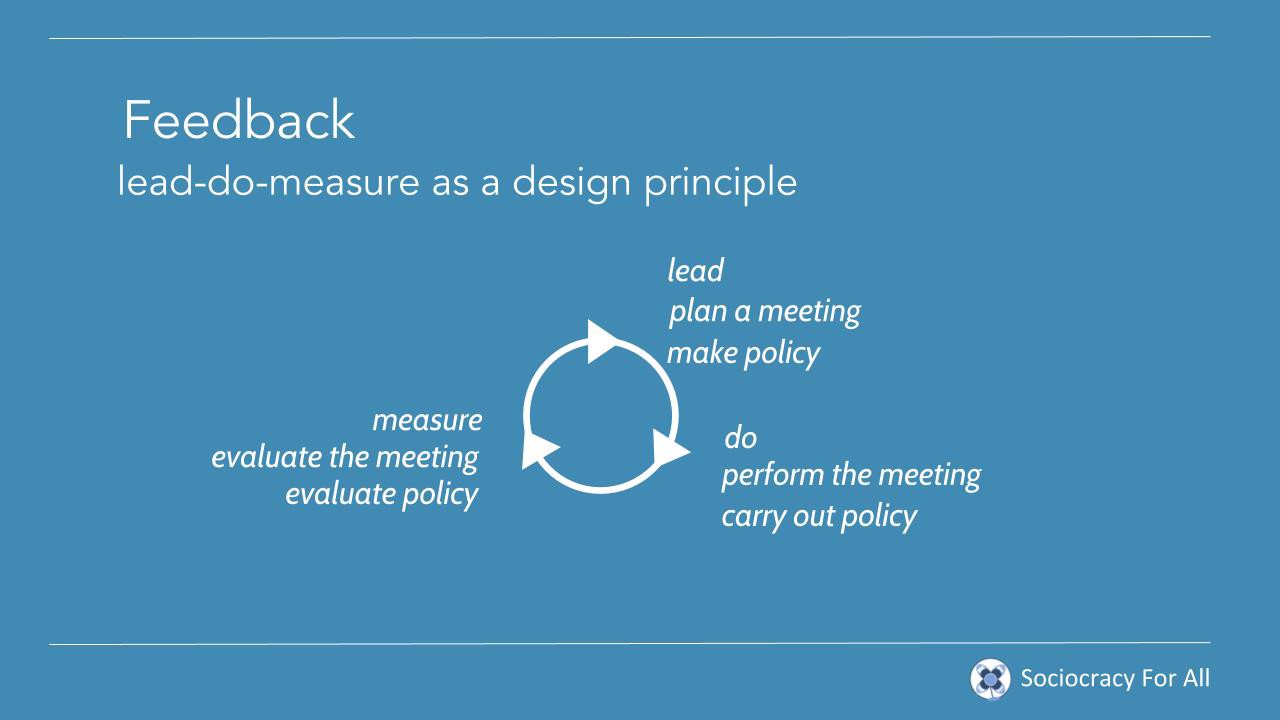 Slide 5 [Creative Commons Attribution-NonCommercial-ShareAlike 2.0 Generic License]
Slide 5 [Creative Commons Attribution-NonCommercial-ShareAlike 2.0 Generic License]
Feedback is a central feature of sociocracy. It is an integral design principle of sociocratic organisations and a universal process applicable in all organisational activities, decisions, and roles, at all levels.
For example at the level of a single meeting: a) we plan a meeting, e.g. collectively putting together an agenda, agreeing the time and place; b) we hold the meeting; c) the closing round of sociocratic meetings is an evaluation round of the effectiveness, efficacy and quality of the meeting, i.e. ?Did we achieve our aims in this meeting?; ?What was the quality of the facilitation??; ?What did we think went well and what do we think we could do better??; What was the quality of the conversation??; ?Were people?s needs met??; ?Were all the issues covered adequately??; ?What did we appreciate about this meeting??. The secretary of the circle records in the meeting?s minutes the comments made at the closing round so that any issues can be considered and addressed in later meetings.
Sociocracy encourages the institution of systematic ways of capturing meaningful information about important aspects of organisational functioning. For example, at the level of a team?s operational performance, Buck and Villines (2007: 165) give the following example:
?In a sociocratically organised hairdressing shop [?] clients are received by the receptionist and then handed off to someone who washes their hair in preparation for the hair dressing process. The hair washer washes hair (?doing?) and is also responsible for measuring the receptionist by asking the client, ?Did you get a cup of coffee while you were waiting? Or, ?what do you think of the new dcor we have in the waiting area?? After the client moves on, the hair washer takes a moment to jot down feedback from the client on a card. Later in the day, she gives all the cards she has filled out to the person with responsibility for setting policy about how clients will be received or how the reception area appears to clients.?
Equally, when making policy decisions, circles are encouraged to ask the question: ?how will we know that this policy is working well??; ?what information will tell us that this is a policy we could keep and not change or discard??; ?what evaluation system do we need to have in place to assess this policy??.
Circles
- take decisions that they think will help them achieve their aim (e.g. appoint a particular person as delegate; decide to hire more people into the circle; decide to invest in new equipment);
- implement these decisions (e.g. person acts as delegate for the term of the role; people are hired into the circle, new equipment are bought),
and then the circles
- use feedback systems (measuring and evaluation) to assess to what extent they have moved forwards (or backwards) in fulfilling the circle aim (e.g. the person is evaluated in their role as delegate by the other circle members; the output of the circle with the new members on board, or using the new equipment, is evaluated against the past output when the new members or the new equipment were not there).
For a detailed manual on how to practise sociocracy, please see Jennifer Ted?s and Jerry Koch-Gonzalez?s book: ?Many Voices, One Song: shared power with sociocracy?
